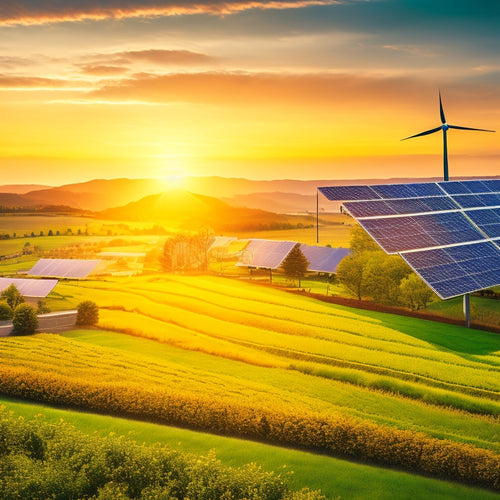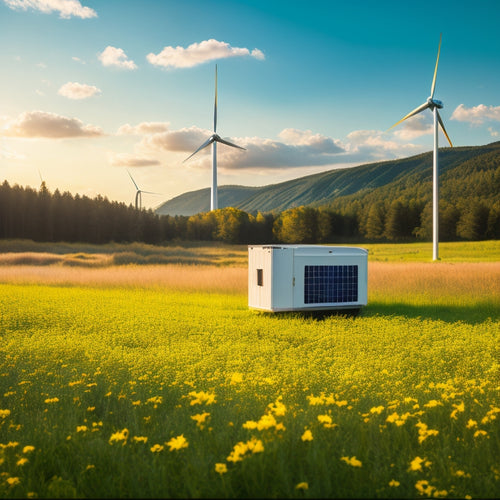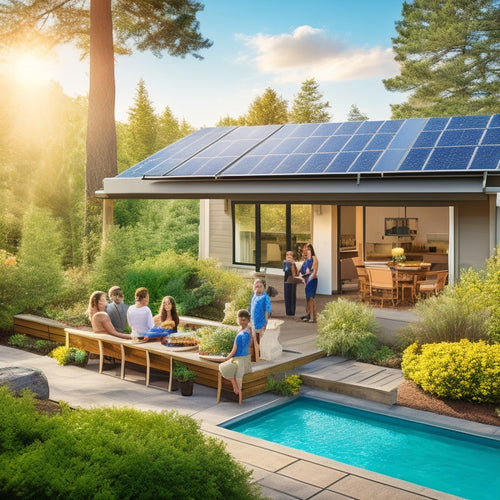
Powering Your Independence: A Guide to Inverters
Share
You're about to take an essential step towards energy independence by selecting the right inverter for your system, a decision that will greatly impact the reliability, efficiency, and overall performance of your off-grid or backup power setup. To get it right, you'll need to evaluate your power requirements, assess daily energy usage, and choose the right inverter type, such as pure sine or modified sine, based on your device compatibility and energy source. With an in-depth exploration of inverter efficiency ratings, size, and capacity, safety features, and integration with energy storage systems, you'll be well on your way to achieving the independence you're looking for.
Overview
- Evaluate power requirements and inverter compatibility to ensure seamless integration with energy sources and devices.
- Choose the right inverter type, such as pure sine or modified sine, based on the application and devices being powered.
- Consider inverter efficiency ratings, with 90-95% being suitable for small to medium systems and 95-98% for large-scale applications.
- Ensure inverter size and capacity meet power requirements, with a 10-20% oversizing buffer for unexpected surges.
- Look for essential safety features, including overload protection, short circuit prevention, and compatibility with battery chemistry and voltage.
Choosing the Right Inverter Type
Several key factors come into play when choosing the right inverter type for your specific needs.
You'll need to evaluate the type of power required by your devices, as well as the inverter's compatibility with your energy source. Additionally, it's crucial to assess daily energy usage and roof space for appropriate inverter sizing Energy Requirements and Sizing to guarantee maximum energy harvesting.
Pure sine inverters provide high-quality power suitable for sensitive electronics, while modified sine inverters are better suited for simpler applications like powering tools.
Research inverter brands, such as Xantrex or Magnum, to find one that meets your needs.
Inverter applications, including off-grid or backup power systems, also play a role in your decision.
Inverter pricing varies widely, but be sure to include warranties and customer support when making your choice.
Understanding Inverter Efficiency Ratings
When sizing up an inverter, grasping the concept of efficiency ratings is vital to optimize your system's performance. Inverter technology has made noteworthy advancements, but it's essential to understand how efficiency standards impact your energy output. Efficiency ratings measure how much of the input power is converted to usable AC power. Look for inverters with high efficiency ratings, as they reduce energy waste and heat generation.
| Efficiency Rating | Description |
|---|---|
| 90-95% | High efficiency, ideal for small to medium-sized systems |
| 95-98% | Premium efficiency, suitable for large-scale applications |
| 98-100% | Top-tier efficiency, for critical systems requiring maximum output |
| <90% | Low efficiency, may not be suitable for most applications |
Inverter Size and Capacity Matters
Your inverter's size and capacity have a direct impact on your system's overall performance, and choosing the right one is critical to guarantee you're getting the most out of your energy output.
When selecting an inverter, consider your power requirements and the type of appliances you'll be running, such as prioritizing essential devices for initial power allocation load calculations.
Oversizing your inverter by 10-20% can also accommodate unexpected power surges. Inverter wattage is a key factor, as it determines how much power your system can handle.
Ascertain the inverter's continuous power rating matches or exceeds the total wattage of your appliances. Additionally, consider the inverter voltage, which must match the voltage of your battery bank and appliances.
A correctly sized inverter will provide efficient energy conversion, minimizing energy losses and maximizing your independence from the grid.
Safety Features to Look For
Most modern inverters come equipped with a plethora of safety features designed to protect you, your appliances, and the system itself from potential hazards. When selecting an inverter, you should look for built-in overload protection, which automatically shuts down the system in the event of excessive power demand. This prevents damage to your appliances and the inverter itself.
Additionally, short circuit prevention is a must-have feature, as it detects and interrupts electrical shorts before they cause damage or even fires. It's vital to confirm the inverter is compatible with your battery chemistry, voltage, and charging requirements to prevent damage and system failure inverter compatibility.
Moreover, high-quality inverters with advanced features improve battery charging and discharging reliability. Other essential safety features include overvoltage protection, undervoltage protection, and overheating protection.
Integration With Energy Storage Systems
The collaboration between an inverter and an energy storage system (ESS) is essential to guaranteeing a reliable and efficient off-grid power solution.
When selecting an inverter, you'll want to take into account its compatibility with your battery bank. Look for inverters with advanced battery management systems that can monitor and control charging and discharging. This guarantees peak performance, prolongs battery life, and prevents damage.
Additionally, the inverter's grid interaction capabilities are vital. It should be able to seamlessly switch between grid-tied and off-grid modes, providing a stable power supply.
Frequently Asked Questions
Can I Use an Inverter With a Generator as a Backup Power Source?
You can use an inverter with a generator as a backup power source, but it's essential to guarantee generator compatibility and choose the right inverter type, such as a grid-tie or hybrid inverter, to optimize performance and safety.
Are Inverters Suitable for Powering Medical Equipment at Home?
You'll want to confirm the inverter's power rating matches your medical equipment's specifications, and verify medical device compatibility to secure safe, reliable operation; look for inverters with high surge capacity and low total harmonic distortion for best performance.
Do I Need a Separate Inverter for Each Individual Appliance?
You'll need to determine if a single inverter can handle multiple appliances, considering inverter types and appliance compatibility; for instance, a high-frequency inverter might not be suitable for sensitive medical equipment, requiring a separate, specialized inverter for each unique appliance need.
Can I Install an Inverter Myself, or Do I Need a Professional?
You're evaluating DIY inverter installation against hiring a pro; consider your electrical knowledge and comfort with DIY safety, as improper connections can be hazardous, and a professional guarantees a safe, efficient setup for your off-grid freedom.
Are There Any Specific Certifications or Standards I Should Look For?
When selecting an inverter, you'll want to look for certifications like UL (Underwriters Laboratories) or ETL (Intertek), ensuring compliance with safety standards, and check for efficiency ratings like CEC (California Energy Commission) or IEEE (Institute of Electrical and Electronics Engineers) standards.
Ready to Buy
"Flipping the switch to freedom, you've finally found the perfect inverter to fuel your independence. From choosing the correct converter to crafting an all-encompassing energy system, you've conquered the intricacies. With safety features safeguarding your setup and efficient energy flow, you're ready to power your passions. Seamlessly synchronizing with storage solutions, your system shines. Now, spark your self-sufficiency and shine with confidence, knowing your inverter is the heart of your harmonious hybrid haven."
Related Posts
-

Net Metering in Renewable Energy's Future
Net metering's future is vital for driving renewable energy growth and financial savings. You can reduce your electri...
-

Sustainable and Eco-Friendly Generators for a Reduced Carbon Footprint
Sustainable and eco-friendly generators are perfect for cutting your carbon footprint and increasing energy efficienc...
-

Top-Rated Home Solar Power Kits for Achieving Energy Independence
Top-rated home solar power kits enable you to achieve energy independence by greatly cutting your energy costs. You c...


